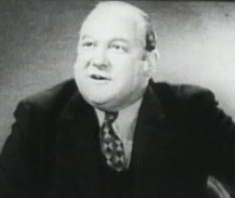- Arthur Quirk Bryan
Infobox actor
name = Arthur Q. Bryan

imagesize =
caption | birthdate = birth date|1899|5|8|mf=y
location = Brooklyn,New York USA
deathdate = death date and age|1959|11|18|1899|5|8|mf=y
deathplace =
othername =
yearsactive =
spouse =
homepage =academyawards =
emmyawards =
tonyawards =Arthur Quirk Bryan (
May 8 ,1899 –November 18 ,1959 ) was aUnited States comedian andvoice actor , remembered best for his longtime recurring role as well-spoken, wisecracking Dr. Gamble on the legendary radio comedy "Fibber McGee & Molly " and for creating the voice of cartoon legendElmer Fudd . His grave is located atValhalla Memorial Park Cemetery .Biography
Born and raised in
Brooklyn, New York , Bryan grew up with a deep desire to go into show business, stumbling through the industry for several years before finding steady if unsatisfying work as a bit player and occasional film narrator inHollywood . But it began to pay off when Bryan came to prominence in his late 30s as the voice of Egghead andElmer Fudd atWarner Brothers animation unit, headed byLeon Schlesinger .Along with
Bugs Bunny ,Daffy Duck andPorky Pig , all voiced byMel Blanc , one of Warner's early big stars was Bryan's Elmer Fudd. The slow-talking, slower-witted, enunciation-challenged Mr. Fudd is a game hunter whose Brooklynesque speech (courtesy of Bryan's own childhood upbringing in the borough) was exaggerated for memorable effect by his habitual substitution of "W " for the letters "L " and "R ," an effect further immortalised by the tongue-in-cheek screen credits of the 1941 Bugs Bunny short, "Wabbit Twouble ". (1941).When watching him perform, director
Bob Clampett (or "Wobert Cwampett" in the screen credit) thought Bryan's girth added to the hilarity of his dialogue, and redesigned Fudd as a fat man. After a few shorts, Clampett decided it was a mistake, and Fudd returned to his classical form. But fat or slimmed, Bryan's Fudd was so popular, that the character's shorts were used to create and develop the character of Bugs Bunny, with the first "official"Bugs Bunny appearance coming in the Fudd cartoon, "A Wild Hare " (1940).Bryan's work in animation was not left unnoticed by
radio producers. Although his first forays into that medium were inevitably accompanied by instructions that he use the Fudd voice, Bryan soon came to the attention ofDon Quinn andPhil Leslie , the production and writing team responsible for "Fibber McGee and Molly " and their supporting characters, two of whom spun off into their own radio hits, "The Great Gildersleeve " and "Beulah".The Gildersleeve character, played by
Harold Peary , became series broadcasting's first successful spin-off hit; that plus the onset ofWorld War II (which cost "Fibber McGee & Molly" their Mayor LaTrivia, whenGale Gordon went into the Coast Guard in early 1942, and "The Old Timer" Bill Thompson was drafted almost a year later) nabbed nearly every other remaining male voice.Quinn and Leslie hired Bryan first for the new "Great Gildersleeve" series, to play the part of one of Gildersleeve's cronies, Floyd Munson the barber (originally played by
Mel Blanc , and no relation to the later character of barberFloyd Lawson played byHoward McNear on television's "The Andy Griffith Show "). His work on the series (in Bryan's natural voice) so impressed the pair that Bryan was added to the cast of their main show, "Fibber McGee and Molly", in 1943.On "Fibber", Bryan found himself in the unusual position of being smarter than, more educated than, and generally superior to his foil, titular braggart McGee. Playing Doc Gamble, Bryan was a polar opposite of the Fudd character---Gamble was well-spoken, even-tempered, and usually got the best of McGee, which Elmer could never do with Bugs.
Bryan never earned a big break in film in spite of his vocal success; his film work remained largely uncredited cameos, usually employing the Fudd persona, or minor supporting roles in B-movies. But he found regular film work regardless, appearing in dozens of films over the years, in such successful releases as "Samson and Delilah" (1949); two
Bob Hope /Bing Crosby "Road" films, "Road to Singapore " (1940) and "Road to Rio " (1947); and theOzzie and Harriet feature "Here Come the Nelsons " (1952).Bryan continued as the "Fibber" show's secondary male lead, even after Thompson and (for a time) Gordon returned to the show, and he stayed as Dr. Gamble all the way through its final incarnation on the NBC "Monitor" series in 1959, as well as playing Floyd on "Gildersleeve" through its conclusion in 1954. Bryan's final original work as Fudd came in the Warner Bros.
Edward R. Murrow spoof "Person to Bunny " (1960).He didn't live to see that cartoon hit the screen, however: Bryan died of a heart attack in November, 1959, with Hal Smith and later
Mel Blanc himself taking over the voice of Elmer Fudd.The DVD specials for some cartoons such as "
What's Opera, Doc? ", in "Looney Tunes Golden Collection ", includes bits of conversation between Bryan and Mel Blanc, affording a rare opportunity to hear them working together, and to hear Bryan's natural voice (no trouble with R's and L's).External links
*
* [http://154.ca/otr/archive.cgi?program=fibbermcgeeandmolly "Fibber McGee & Molly"] , radio episodesPersondata
NAME=Bryan, Arthur Q.
ALTERNATIVE NAMES=
SHORT DESCRIPTION=Voice Actor
DATE OF BIRTH=May 8 ,1899
PLACE OF BIRTH=Brooklyn, New York
DATE OF DEATH=November 18 ,1959
PLACE OF DEATH=
Wikimedia Foundation. 2010.
